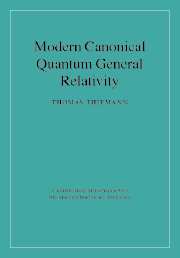Book contents
- Frontmatter
- Contents
- Foreword, by Chris Isham
- Preface
- Notation and conventions
- Introduction: Defining quantum gravity
- I CLASSICAL FOUNDATIONS, INTERPRETATION AND THE CANONICAL QUANTISATION PROGRAMME
- II FOUNDATIONS OF MODERN CANONICAL QUANTUM GENERAL RELATIVITY
- III PHYSICAL APPLICATIONS
- IV MATHEMATICAL TOOLS AND THEIR CONNECTION TO PHYSICS
- References
- Index
Foreword, by Chris Isham
Published online by Cambridge University Press: 04 August 2010
- Frontmatter
- Contents
- Foreword, by Chris Isham
- Preface
- Notation and conventions
- Introduction: Defining quantum gravity
- I CLASSICAL FOUNDATIONS, INTERPRETATION AND THE CANONICAL QUANTISATION PROGRAMME
- II FOUNDATIONS OF MODERN CANONICAL QUANTUM GENERAL RELATIVITY
- III PHYSICAL APPLICATIONS
- IV MATHEMATICAL TOOLS AND THEIR CONNECTION TO PHYSICS
- References
- Index
Summary
Over half a century of collective study has not diminished the fascination of searching for a consistent theory of quantum gravity. I first encountered the subject in 1969 when, as a young researcher, I spent a year in Trieste working with Abdus Salam who, for a while, was very interested in the subject. In those days, the technical approaches adopted for quantum gravity depended very much on the background of the researcher: those, like myself, from a theoretical particle-physics background used perturbative quantum field theory; those whose background was in general relativity tended to use relatively elementary quantum theory, but taking full account of the background general relativity (which the other scheme did not).
The perturbative quantum field theory schemes foundered on intractable ultraviolet divergences and gave way to super-gravity – the super-symmetric extension of standard general relativity. In spite of initial optimism, this approach succumbed to the same disease and was eventually replaced by the far more ambitious superstring theories. Superstring theory is now the dominant quantum gravity programe in terms of the number of personnel involved and the number of published papers, per year, per unit researcher.
However, notwithstanding my early training as a quantum field theorist, I quickly became fascinated by the “canonical quantization”, or “quantum geometry,” schemes favored by those coming from general relativity. The early attempts for quantizing the metric variables were rather nave, and took on various forms according to how the intrinsic constraints of classical general relativity are handled. In the most popular approach, the constraints are imposed on the state vectors and give rise to the famous Wheeler–DeWitt equation arguably one of the most elegant equations in theoretical physics, and certainly one of the most mathematically ill-defined.
- Type
- Chapter
- Information
- Modern Canonical Quantum General Relativity , pp. xvii - xviiiPublisher: Cambridge University PressPrint publication year: 2007

